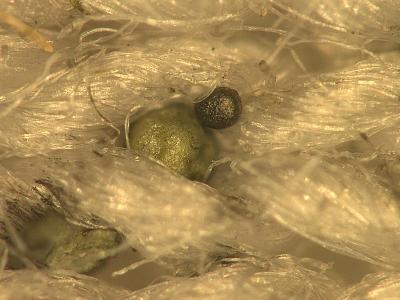Green is in. Even the army is making sure to use environmentally friendly paint on its bombers and environmentally conscious people who have made great efforts to put ethical bullets into mainstream use will be happy that their lead-free status will no longer leave crimes unsolved.
Scientists in Texas say a new, inexpensive test requires only a single speck of gunshot residue (GSR) smaller than the period at the end of this sentence and it could boost the accuracy of results at crime scenes involving gunplay.
Many of the current methods are susceptible to outside interferences that can produce false positive or false negative results. For example, most tests require the presence of lead for a valid reading, including two of the three mainstays of residue analysis — the sodium rhodizonate test and scanning electron microscopy with energy dispersive x-ray detection.

But lead is disappearing from ammunition, notes Sam Houston State University graduate student Garrett Lee Burleson in a paper on the subject. That potentially toxic metal poses environmental hazards at outdoor firing ranges, where it can leach into groundwater. In response, manufacturers have begun to create safer, environmentally friendly ammunition out of other metals, such as zinc and aluminum alloys.
Burleson and his advisor, chemist Jorn Chi Chung Yu, described their new method in a poster at the national meeting of the American Chemical Society. It extracts almost all components of gunpowder residue from particles about 15 times smaller than the width of a human hair, without the use of chemical reagents. After extraction, gas chromatography coupled with a nitrogen phosphorus detector is used to separate and identify the analytes.
“Gunshot residue tests are done in almost every case where a shooting has taken place,” Burleson said. “The main focus of our research is to develop a method that will help credibility of gunshot residue evidence in court. You can get results with this test in 30 to 40 minutes with the new test. In addition you only need small amounts of evidence to run the test.”
This recent trend toward lead-free ammunition, Burleson said, has decreased reliability of gun shot residue analysis and created the need for smarter tests to identify more diverse components of residue in gunpowder, including elements like stabilizers and plasticizers, which are added in the powder during the manufacturing process for safety reasons.
“When a gun fires, the gunpowder explodes, producing gases at enormous pressure that propels the bullet out of the barrel of the firearm,” explained Burleson, a graduate student in the Master of Science in Forensic Science Program at Sam Houston State University. “Some of the residue from that explosion is deposited on the hands of the shooter and the clothing of the victim.” Burleson’s new test, which uses a technology called solid phase micro-extraction combined with gas chromatography, focuses on chemical compounds present in that ejected material. “When you have a residue particle, no matter how small, it’s going to contain signatures of every element in that powder.”
These signatures offer a wider range of detection possibilities compared to traditional methods, he said. Using an alternative method with a scanning electron microscope, for example, a forensic examiner would perform a search for lead, passing up numerous powder constituents in the analysis. “You would just look for the one little piece of metal that might be there, so the analysis could take hours,” Burleson said.
“If you’re looking for powder, however, there’s a lot more of it. You’re getting more of the residue to analyze. It makes it a much more efficient method of detection.” For example, a distinctive combination of certain chemicals, such as diphenylamine, ethyl centralite and nitrodiphenylamine, is typically found only in explosive mixtures and therefore allows for a simple analysis of gunplay at a crime scene.
In contrast, another traditional test for finding gunshot residue, the modified Griess test, often fails because it lacks such specificity. Its analysis is based on the detection of Nitrogen-based compounds called nitrites, which are gunpowder byproducts. But these compounds are also found elsewhere, leading to possible ambiguity in testing.
“Many chemical cleaners — anything that can be used to take off motor oil or freight dust — will test positive for gunshot residue using the Griess test,” Burleson said.
That would make the reading a false positive, which opens the door in court cases for reasonable doubt and possibly incarcerating an innocent person. “The worst thing you can possibly say is, ‘There’s a chance I’m wrong.’ Our preliminary results indicate you can determine the presence of gunshot residue with a high level of confidence.”
More efficient testing also would reduce the need for extraneous tests that require time and money while draining resources from a criminal justice system that cannot afford it, Burleson said.
The research was funded by the College of Criminal Justice and Department of Chemistry at Sam Houston State University.
Burleson’s test could be used as a preliminary or confirmatory one. “As far as a stand-alone test, it’s an excellent, reliable and cheap test to do,” he said. “But for the sake of clarity and thoroughness, examiners will usually run multiple tests, such as the sodium rhodizonate test at the crime scene, and they could then confirm the findings with my method.”




Comments